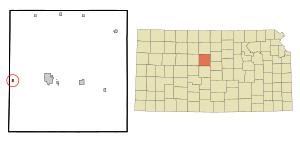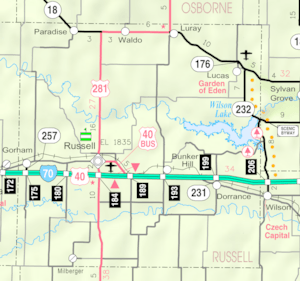Gorham, Kansas facts for kids
Quick facts for kids
Gorham, Kansas
|
|
|---|---|

Location within Russell County and Kansas
|
|

|
|
| Country | United States |
| State | Kansas |
| County | Russell |
| Founded | 1886 |
| Incorporated | 1941 |
| Named for | Dodge Gorham |
| Area | |
| • Total | 0.24 sq mi (0.62 km2) |
| • Land | 0.24 sq mi (0.62 km2) |
| • Water | 0.00 sq mi (0.00 km2) |
| Elevation | 1,916 ft (584 m) |
| Population
(2020)
|
|
| • Total | 376 |
| • Density | 1,570/sq mi (606/km2) |
| Time zone | UTC-6 (CST) |
| • Summer (DST) | UTC-5 (CDT) |
| ZIP code |
67640
|
| Area code | 785 |
| FIPS code | 20-27000 |
| GNIS ID | 475207 |
Gorham is a small city in Russell County, Kansas, in the United States. In 2020, about 376 people lived there.
Contents
Gorham's History
Early Settlement and Founding
In April 1872, settlers from Pennsylvania created a community where Gorham is now. They built it along the Kansas Pacific Railway. A man named Elijah Dodge Gorham from Illinois gave the town its name. He planned out the town in 1879.
Gorham officially started the town in July 1886. He wanted it to be a local trading center. He even gave land for a Catholic Church and a cemetery. He also opened several businesses. These included a general store, a grain elevator (for storing grain), a post office, a lumberyard, and a coal yard. More grain elevators and a stockyard opened later. This helped Gorham become a farming community.
Growth from Oil Discovery
In the 1920s, oil was found in Russell County. This discovery completely changed the local economy. Big companies like Texaco and Stanolind started working in the area. This made Gorham grow a lot.
New school buildings were built in 1922, 1930, and 1949. Gorham officially became a city in 1941. By 1944, it had many different businesses. It also had two oil field production companies and public schools. From the 1950s to the early 1980s, the city continued to expand. More homes were built during this time.
Geography of Gorham
Where is Gorham Located?
Gorham is in west-central Kansas. It is about 121 miles (195 km) northwest of Wichita. It is also about 237 miles (381 km) west of Kansas City. Denver is about 355 miles (571 km) to the east.
The city is just over a mile north of Interstate 70. This is a major highway. Gorham is also about 9 miles (14 km) west of Russell. Russell is the main city in the county.
Natural Surroundings
Gorham is in the Smoky Hills region. This area is part of the larger Great Plains. The Smoky Hill River is about 9 miles (14 km) south of Gorham. The Saline River is about 11 miles (18 km) to the north.
The city covers a total area of 0.24 square miles (0.62 km2). All of this area is land.
Population and People
| Historical population | |||
|---|---|---|---|
| Census | Pop. | %± | |
| 1950 | 375 | — | |
| 1960 | 429 | 14.4% | |
| 1970 | 379 | −11.7% | |
| 1980 | 355 | −6.3% | |
| 1990 | 284 | −20.0% | |
| 2000 | 360 | 26.8% | |
| 2010 | 334 | −7.2% | |
| 2020 | 376 | 12.6% | |
| U.S. Decennial Census | |||
Population in 2020
The 2020 United States census counted 376 people living in Gorham. There were 147 households and 96 families. About 30.6% of households had children under 18. The average household had 2.7 people.
About 29.5% of the population was under 18 years old. Around 15.2% were 65 years or older. The average age in Gorham was 36.3 years.
Economy and Jobs
Working in Gorham
In 2012, most people over 16 years old in Gorham were working. About 77.1% of the civilian workforce had jobs. The types of jobs people had included:
- Management, business, science, and arts (23.4%)
- Sales and office jobs (23.4%)
- Natural resources, construction, and maintenance (19.6%)
- Service jobs (19.6%)
- Production, transportation, and material moving (13.9%)
The top industries for workers were construction (21.1%), education and health care (18.7%), and arts and food services (11.5%).
Cost of Living
Living in Gorham is generally affordable. Compared to the U.S. average, the cost of living index for Gorham is 80.7. This means it's cheaper than many other places. In 2012, the average home value was $59,700.
Education in Gorham
Local Schools
The public schools in Gorham are part of the Russell County USD 407 school district. The high school for the district is Russell High School.
In 1967, Gorham's public schools joined the Russell County Schools. This was required by state law. Over time, some schools closed. Gorham High School closed in 1984. Gorham Elementary School closed in 1997. The mascot for Gorham High School was the Gorham Oilers.
City Infrastructure
Transportation Routes
Interstate 70 and U.S. Route 40 both run together. They are just over a mile south of Gorham. The older part of U.S. 40 goes right through the city. It crosses 176th Street, which is a paved county road.
The Union Pacific Railroad also has a freight train line that goes through Gorham. This line is called the Kansas Pacific (KP) line.
Utilities and Services
Midwest Energy, Inc. provides electricity to the people living in Gorham. Gorham Telephone offers landline phone service. They also provide cable television and internet. Most homes use natural gas for heating. This service comes from Kansas Gas Service. The city government takes care of water, sewer systems, and trash collection.
Media
Gorham is in the Wichita-Hutchinson, Kansas television market. This means residents watch TV channels from that area.
See also
 In Spanish: Gorham (Kansas) para niños
In Spanish: Gorham (Kansas) para niños

